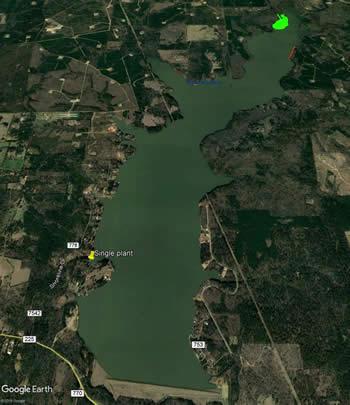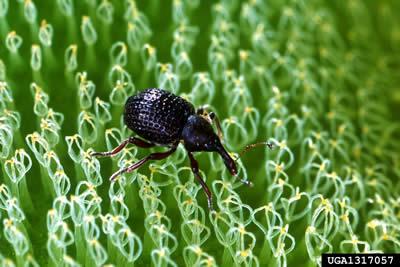
February 24, 2018 - Like an aquatic monster with no apparent agenda other than quietly taking a passel of water bodies hostage, Giant Salvinia continues to sneak its way across eastern Texas. It doesn't discriminate against size, either. Large or small, no freshwater reservoir, river or stream in these parts is "salvinia proof."
Giant Salvinia is an invasive, free-floating fern native to South America that can spread incredibly quick. Left unchecked under the right conditions, the plant can choke off access and block out sunlight critical to a watery ecosystem.
Experts believe it was brought to the United States on cargo vessels carrying tainted shipments of tropical plants or fish. It was likely introduced to public waters when someone dumped a contaminated fish aquarium into a lake, or when an water garden or pond overflowed, spilled into a creek and subsequently drained into a watershed.
The plant was first discovered in Texas in the late 1990s on Toledo Bend and it has since invaded on a long list of East Texas lakes that seems to grow larger every year. It has also been found Louisiana and several other southern states.
The Newest Footprint
Texas infestations date back for years on lakes Caddo, Fork, Martin Creek, Murvaul, Toledo Bend, Sam Rayburn and Naconiche. It also has a history on Lake O' the Pines, Palestine, Wright Patman, Gilmer, Texana Sheldon, Brandy Branch and Welsh.
Also known as Salvina molesta, the plant's most recent footprint landed on 2,200 acre Lake Nacogdoches.
A local fisherman made the initial find in the Yellow Bank Creek arm of the lake on Jan. 30. It was hoped that the plant might be confined to a single cove, but a subsequent investigation conducted on Feb. 5 by Texas Parks and Wildlife's aquatic invasive species team showed the noxious plant is much better established and more widespread than originally believed.
That's the word from John Findeisen, TPWD's point man when it comes to dealing with aquatic invasives on Texas waters. According to Findeisen, crews located a heavy infestation along a northwestern bank near the mouth of Little Loco Creek and a smaller patch along the eastern shore in the vicinity of the Hayter Hunting Club camp house. The biologist estimates the total coverage area to be about 30 acres.
"It's mixed in with the cut grass and torpedo grass (hay grass)," Findeisen said. "My guess is it has been there since last summer. Possibly since last spring."
To Spray or Not to Spray
Cut grass and torpedo grass are native emergent plants that root to bottom in shallow water and grow beyond the surface. Both provide valuable fish habitat.
Findeisen says the location, distribution and floating nature of giant salvinia presents some difficult challenges to contend with as far as herbicide treatment goes. That's because the contact herbicide the department uses to kill the plant can do collateral damage to cut grass, torpedo grass and other types of more desirable aquatic vegetation.
Giant salvinia, on the other hand, doesn't root to bottom. Instead, it floats on the surface and drifts wherever the wind or current takes it. The plant clings to boat trailer bunks, duck decoys or anything else it comes into contact with. This means it can be easily transported from one lake to another. The plant can withstand sub-freezing temperatures and reproduces by vegetative fragmentation.
Findeisen has learned from experience that there are certain situations when using herbicide is not the best option for treating giant salvinia infestations.
The Clipper brand herbicide TPWD uses contains flumioxazin. The biologist says herbicide kills aquatic plants down to the water's surface, but doesn't harm rooted plants below the surface, allowing for regrowth in time. It is usually dispersed from airboats.
In some cases - like the one at Lake Nacogoches - Findeisen thinks herbicide treatment can actually do more harm than good because it eliminates the natural barriers (cut grass and torpedo grass) that are helping to to keep the plant contained.
"The situation at Lake Nacogdoches is similar to what we ran into at Lake Murvaul two years ago," Findeisen said. "We thought we could eradicate the salvinia on Murvaul without hurting the cut grass too bad. But what we ended up doing is taking the cut grass out. That gave the salvinia that didn't get hit with herbicide free rein to float all over the lake.
"The torpedo grass and cut grass are great habitat," Findeisen added. "If we could eradicate the salvinia with herbicide it might be an option, but knowing we can't eradicate it there is no reason to destroy that habitat."
Findeisen says the department has been successful in eradicating Giant salvinia infestations in the past, but it doesn't happen very often. Often times, it shows back up a few years down the road. Recent cases at Brandy Branch Reservoir near Longview and Lake Fork come to mind.
"It's rare for us to be able to eradicate it," Findeisen said. 'We managed to do it at Brandy Branch when it showed up at the boat ramp. We learned about early and were able to get it taken care of with herbicide before it was able to spread.
"The first time it showed up at Lake Fork a couple of years ago we we were able to contain it in Chaney Branch with booms and knock it out," he added. "Then it showed up again this again this fall in White Oak Creek in an entirely different part of the lake."
TPWD news releases indicate the plant occupied about 12-15 acres when it was found at Lake Fork last fall. About 90 percent of the infestation was confined to White Oak Creek by booms. There rest of the plants dispersed to other areas and could not be contained.

The Weevils are Coming
Since eradication is out of the question at Lake Nacogoches, Findeisen says the department's main goal in dealing with the state's newest giant salvinia infestation is the same as on every other lake where it has taken hold: Try to prevent the plant from spreading to other areas of the lake, including the city water intake.
The biologist says the aquatic invasive species team will monitor the reservoir every few weeks. Herbicide will be used to treat any mats isolated away from other vegetation.
"We'll also be releasing Giant salvinia weevils there this spring, probably sometime in April and May," Findeisen said. "The weevils are one of the natural control vectors for Giant salvinia over in Brazil. We've used them with good success on Dam B (Steinhagen Lake), Sheldon Lake and areas of Caddo Lake."
Findeisen says the weevils are about the size of a pin head. The insects eat the plant and reproduce on the leaves. When the eggs hatch the larvae burrow into the plant's stem. This stops the plant from moving nutrients and causes it to die, the biologist said.
TPWD has its own weevil source stock. The insects are grown in greenhouses in Karnack, Jasper and Brookeland. Findeisen says the department also has access to weevils produced in canals operated by the Lower Neches Valley Authority near Anahuac.
The bugs are introduced to lakes by harvesting weevil-infested giant salvinia plants from greenhouses. The vegetation is then transported to infested lakes in tubs and dumped on existing salvinia mats.
Findeisen says the department usually has access to about 360,000-660,000 adult weevils each year. Those bugs are divided among multiple lakes where infestations have been documented. He added that it takes about 450,000 adult weevils to wipe out one acre of giant salvinia in 6-12 months..
"You have to remember that wherever we introduce adult weevils we are also introducing larvae and eggs that are on the plants," Findeisen said.
Down the Road
On a brighter note, Driscoll doesn't look for the plant to cause any significant problems on the lake. The biologist says salvinia tends to thrive in shallow, isolated pockets but doesn't do very well once it breaks away into big, open water. When big rains come, the vegetation usually gets flushed out where it gets beaten up by waves.
"It's going to be there (Lake Nacogdoches) from now on, but I don't look for it to do a whole lot," Driscoll said. "It'll probably be similar to what we've seen in Hausen Bay on Toledo Bend. It will grow in the upper end and then it will occasionally get blown out by wind and runoff.
Lake Nacogdoches is big enough that the waves will kill it if it ever makes it out on the main lake," he added. "Eventually, it'll scatter around the bank and be growing inside the torpedo grass all around the lake. Of course, we don't want it there. But I don't think it will ever be a significant problem."
With spring fishing season around the corner, Findeisen says anglers and boaters who access infested areas on any lake can do their part to help prevent the spread of the plant by making sure their trolling motors and outboards aren't carrying plants before they move to a different area.
Furthermore, the recent find underscores the importance making making sure boats, trailers, tires, duck decoys and outboard engines are free of any vegetation before leaving the boat ramp. Possession or transport of giant salvinia, hydrilla or other prohibited aquatic vegetation in Texas is a Class C misdemeanor punishable by a fine of up to $500 per plant.
Matt Williams is a freelance writer based in Nacogdoches. He can be reached by e-mail, mattwillwrite4u@yahoo.com.









